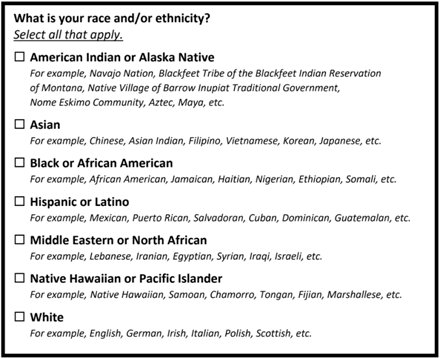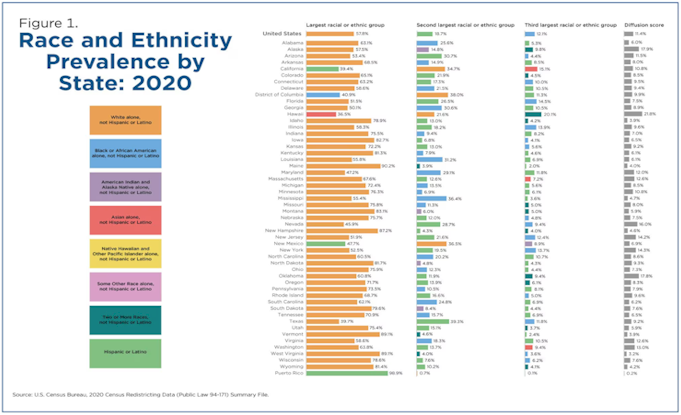|
|
||
|
|
||
|
Federal
Government Announces Revisions to |
||
|
Author:
Madeline Roberts, PhD, MPH 1. Capture race and ethnicity data in one combined question (rather than two questions as previously), 2. a new minimum reporting category of “Middle Eastern and North African” (MENA), and 3. require agencies to collect detailed race and ethnicity data as a default from the individuals they serve. These changes were made effective immediately and full compliance required by 2029. Created in 1977 in an effort to achieve consistent and comparable race and ethnicity information across federal datasets, Statistical Policy Directive No. 15: Standards for Maintaining, Collecting, and Presenting Federal Data on Race and Ethnicity (SPD 15) was revised in 1997 and now in 2024. The new OMB SPD 15 “Race and Ethnicity Question with Minimum Categories Only and Examples” below (Minimum Categories with Multiple Detailed Checkboxes available here)
The previous two-question structure was found to be a source of confusion for respondents, and further, that it obscured accurate race data for the Hispanic and Latinx population in particular. In the 2020 Census, approximately 43% of the self-identified Hispanic and Latinx population either declined to report a race or selected the less informative “Some Other Race” category. Non-response and selection of “Some Other Race” were among the drivers for change, indicating that respondents did not identify with the race and ethnicity categories as presented. Research in conjunction with the Census Bureau showed that a single race/ethnicity question resulted in better data quality and a marked decrease in the number of “Some Other Race” responses. The directive to “select all that apply” allows respondents flexibility to report each of the racial and ethnic categories with which they identify. There is some controversy within the Afro-Latin community as to whether a combined question is appropriate or will lead to an undercounting of the Latinx population. The Census Bureau reports that Afro-Latin population estimates were slightly higher under the combined question when detailed checkboxes and write-in fields were present, though they also recommended further research on Afro-descendant populations based on cognitive interviews regarding how these individuals self-identify. OMB notes that “the race and ethnicity categories set forth are sociopolitical constructs and are not an attempt to define race and ethnicity biologically or genetically.” The US Census Bureau reported the changing racial and ethnic composition in America and growing diversity between 2010 and 2020. The White alone, non-Hispanic population was 63.7% in 2010, which decreased to 57.8% in 2020. The Census Bureau utilizes the Diversity Index, bounded by 0 and 1, to assess “the probability that two people chosen at random will be from different racial and ethnic groups.” This probability increased from 54.9% in 2010 to 61.1% in 2020. It is noteworthy that census methodology for race and ethnicity data collection changed between the 2010 and 2020 census. However, Census Bureau analyses indicate that the reported increase in diversity is a result of true changes in population demographics and also improved question design.
Even so, a study from March 2000 to March 2020 demonstrated that more than half of US clinical trials fail to report race and ethnicity enrollment data, and that these studies under represent minorities, though incremental progress has been made over recent years. From a public health standpoint, race and ethnicity data is paramount for understanding the burden of disease among specific populations as well as for resource programming, advocacy, and developing targeted interventions. In a study setting, inaccurate race and ethnicity reporting can obscure effects among subpopulations and be a potential source of residual confounding. In an applied context, it muddles the picture of where and how to best support community needs. In a data-dependent world, our hope is that improved survey methodology and continued research allow for increasingly accurate population estimates to better serve communities. ■ |
||
|
|
||


